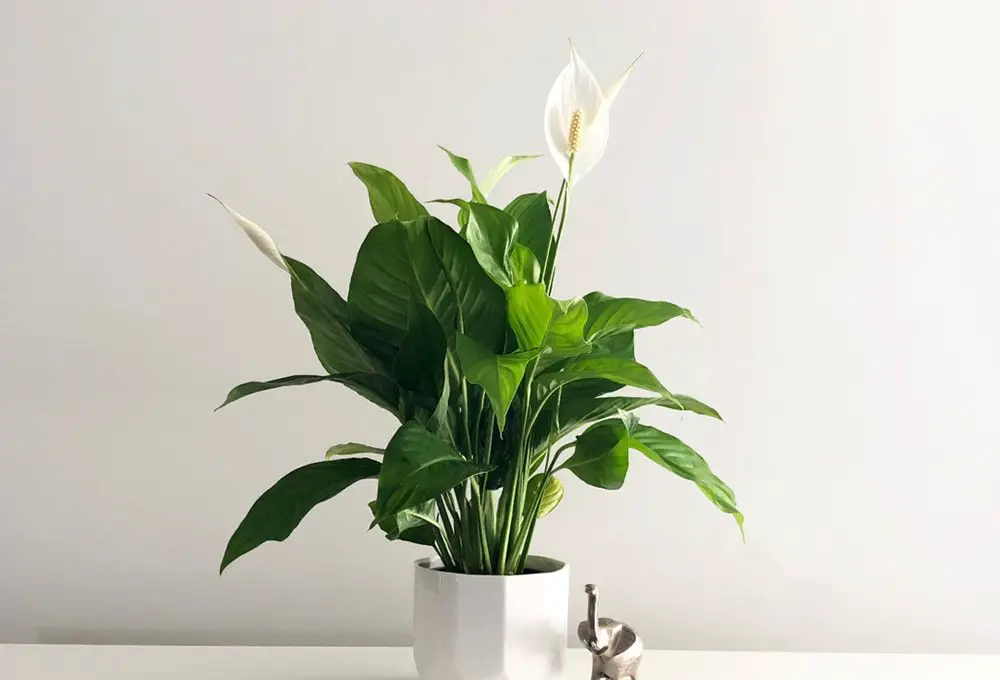
Peace lilies live up to their name. These common house plants are unique and add a gentle beauty to any space they’re in. Despite how delicate they look, they’re also incredibly easy to take care of.
Taking care of a peace lily plant really only requires the basics: water, sunlight, and the occasional pruning to ensure it’s always looking great.
If you’re wondering how to prune a peace lily, you’ve come to the right place. Keep reading to learn about what goes into taking care of these indoor plants and how you can make sure your own peace lily continues to add beauty to your space.
Table of Contents
How to Take Care of a Peace Lily
Before learning how to prune a peace lily, it’s important to understand how to take care of one.
The spathiphyllum, commonly known as the peace lily, is probably most recognized for the big white “flower” that lies on one side of it. The truth is that what most people think is a flower is actually a leaf bract – a specialized leaf. The flowers are actually that cluster that you see in front of the bract. This is contrasted by their thick, waxy, dark green leaves.
The peace lily is a tropical plant that is native to the rainforests of Colombia and Venezuela. It was introduced in Europe in the late 19th century. Since then, it has become popular as a houseplant, and it’s often used in commercial spaces due to its visual appeal and ability to purify the air.
Despite the peace lily plant’s beauty, it’s relatively easy to take care of. If you know the basics, you should be able to keep your peace lily alive and well.
Light
Peace lilies grow on the forest floor, which means they prefer bright, indirect sunlight. If they get a little bit of direct sunlight in the morning, that’s fine, but keep them away from the intense afternoon sun so you don’t burn them.
Peace lilies also do well in low-light conditions, although you may notice their growth slows, and that they may not flower. If this occurs, move your peace lily to an area with brighter, indirect sunlight.
Water
As a tropical plant, peace lilies love to be moist. However, be careful to not overwater your peace lily, as it may cause waterlogged soil, which leads to root rot. Before you water your peace lily, touch the surface of its soil to see if it’s dry. If it’s still moist, wait another day or two before watering.
As a general rule, it’s safer to not water your peace lily enough than to overwater it. Peace lilies can tolerate short periods without water, but they can be dramatic, and you’ll notice that their leaves begin to droop. This isn’t caused for concern – just water your peace lily, and it should once again stand upright. However, if the peace lily leaves start to turn brown, you may be severely underwatering your peace lily.
Now that you know the basics, let’s talk about how to prune a peace lily.
How to Prune a Peace Lily
Sometimes your peace lily needs a little cleaning up. That’s where pruning comes in.
Pruning peace lilies has several benefits for the plant:
- Helps prevent pests and disease
- Removes old, yellow foliage and dead parts
- Encourages the plant’s growth
- Control an overgrown plant taking up too much space
- Gives you control over the look of the plant
Peace lily stalks only bloom once before you’ll notice that they’ve spent and begin to droop. Pruning allows your peace lily to bloom frequently.
Pruning a peace lily is quite simple, and it uses the process of deadheading – removing the dead flower heads from your plants.
Start by cutting the old stalks that have already flowered at the base. Then, move on to removing any of the outer leaves that appear yellow and old, or even dried up.
One mistake to avoid is using dull scissors to prune your peace lily. You run the risk of damaging your plant. For best results, use sharp pruning shears to ensure you get clean cuts.
Another mistake that peace lily owners make is pruning their plants too early. It’s best to prune your peace lily only when the flower dies off.
On the other hand, don’t wait for your foliage to turn yellow and wilt to prune. Your peace lily should be pruned even if the foliage is still green.
Although you should prune whenever the leaves start looking old, deadhead pruning should be done in the late spring.
Other Peace Lily Tips
Here are a few additional tips to help you take care of your peace lily:
- Peace lilies don’t need to be fertilized regularly. If you do choose to fertilize your peace lily, limit it to once or twice a year. You can fertilize more often in the summer to encourage growth.
- Peace lilies have wide leaves that are natural dust magnets. Excessive dust can get in the way of the plant accessing the proper amount of light. You should gently wipe down your peace lilies’ leaves from time to time to keep them clear of dust.
- As a tropical plant, peace lilies enjoy high humidity. If you live in a dry climate, mist your peace lily occasionally to give it some more moisture, or get a humidifier to add more moisture to the air. Likewise, you should keep them at a familiar temperature of about 60 degrees Fahrenheit.
Summary
Peace lilies live up to their name, even when it comes to taking care of them. These minimal plants are easy to take care of, and pruning is a simple way to ensure that they stay looking their best.
Just remember to examine your peace lily regularly to determine whether or not it’s ready to be pruned, and make sure that you have the proper shears for it.
